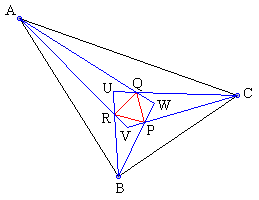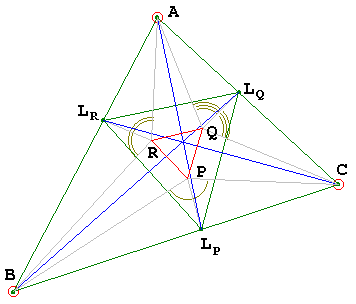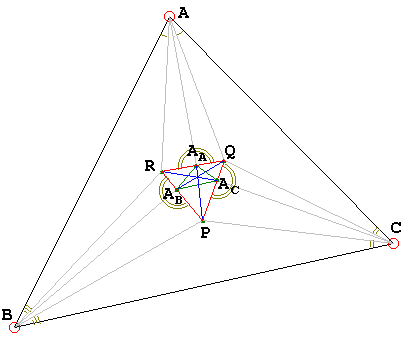 |
Cut The Knot!by Alex Bogomolny |
Of Looking and Seeing
March 2002
![]()
I can't stand it, I have to figure it out.
R. Feynman
The Pleasure of Finding Things Out
Perseus Books, 1999
According to Steven Schwartzman, the word theorem originates with Greek theorema, theorein "to look at." Theater is a related borrowing, since "looking at" a play is what one does in a theater. And further: "A theorem was originally a sight or the act of seeing. Something that is looked at for any moment of time becomes an object of study. In mathematics, after studying a situation or a class of objects, a person hopes to make speculations and then prove them, so theorem came to mean the proof of a speculation that has been arrived at by looking at something." Theater, needless to say, came to mean something altogether different.
Mathematics - the only place where theorems live - and theater make an odd couple. There is nothing more alien to a visit to the theater than making speculations and then proving them. There is nothing less compatible with a mathematician's attitude than passive watching.
Just a few weeks ago, I took my little boy to a stage rendering of Eric Carle's The Very Hungry Caterpillar and The Very Quiet Cricket. It was all very nice until after the cricket found its soul mate and began chirping away its love song. The lights went on, and the two puppeteers took turns explaining how things worked and the purpose of the black background and clothes. The boy, who followed in awe the adventures of the caterpillar and the cricket, showed little interest in the sequel. The public streamed to the exits even as the puppeteers were demonstrating their tricks in controlling the insects with long sticks.
The Magician's Code precludes revealing the workings of a magic trick to a non-magician. There ought to be a similar puppeteers' convention. In theater, the audience is being entertained. Spectators live through a story and experience amazement. Rationalization is hardly consistent with the sensory involvement.
It's different in mathematics, in part because, in mathematics, looking has a different purpose. The desire to grasp and explain -- to figure it out -- is the driving force behind the mathematician's attitude. Even in the simplest cases of proofs without words, mathematician uses the mind's eye to see what's out there. Seeing in mathematics and having figured it out is mostly one and the same. Or, as a corollary from the Strong Law of Small Numbers has it, You can't tell by looking [Guy].
This, of course, is not to say that there's no entertainment or amazement in mathematics. The opposite is true. It's just that one can't buy a ticket to an entertaining math performance. To one extent or another one must be an actor in the play, not a passive spectator.
Ceva's theorem might have been discovered by looking, but was not until late in the 17th century. Frank Morley did not draw the diagrams at all (see [Oakley] and Clark Kimberling's account). So Morley's theorem was not discovered by looking either, and I do not believe it might have been. It's most spectacular nonetheless.
It was observed much later [Sastry] that Morley's configuration is a rich source of numerous concurrences, which I am sure F. Morley has plainly overlooked. The reason I think so is that Morley's theorem is merely a by-product of Morley's investigation into a hierarchy of constructions generalizing the Clifford chain. His goal was to develop a theory, not study disparate examples.
More concurrences were suggested quite recently by L. Cusick and Antreas P. Hatzipolakis. They are not as curious as Morley's theorem itself and nowhere as useful as Ceva's. Their main source of attraction is in their quantity and in the fact that some are in fact only near hits (or is it near misses?), appearances notwithstanding.
Morley discovered 27 equilateral triangles formed by three families of three parallel lines each. The number of possible concurrences in the diagram is quite overwhelming. To keep the total to a manageable size, the applet below only incorporates two of Morley's triangles. One is formed at the intersections of adjacent internal trisectors (PQR in the diagram below), the other by their external counterparts (not shown, P'Q'R' in what follows)

The lines PP', QQ', RR' are concurrent. Put differently, triangles PQR and P'Q'R' are perspective. Following is a complete list of triangles available in the applet below that may be (occasionally) mated into perspective pairs.
In addition, the applet allows one to consider pairs of isogonal lines instead of two angle trisectors. This is achieved by clicking on the numerator and the denominator of the fraction at the bottom of the applet. Numbers increase/decrease if clicked on to the left/right of their central vertical lines. The number that may be displayed in the upper left corner of the applet is the area of the triangle formed by three straight lines whose concurrence is being investigated. The number, of course, is only approximate.
For example, let's establish a couple of concurrences. Our main tool will be Ceva's theorem. I shall assume angles A, B and C equal to 3a, 3b and 3g, respectively.
Triangles ABC and LLL (AQC-AC) are perspective

Indeed, let LP, LQ and LR be the points of intersection of bisectors of angles CPB, AQC, and BRA with sides CB, AC and BA, respectively. We want to show that triangles ABC and LPLQLR are perspective. Indeed, from the Law of Sines,
so that
and similarly for the other two sides. As the result, we get
which, by Ceva's theorem exactly means that the three lines are concurrent.
![]()
Triangles PQR and AAA (ABC-PQR) are perspective

Let AA, AB, AC be the feet of perpendiculars from A, B, and C to RQ, PR and PQ, respectively. We want to show that triangles PQR and AAABAC are perspective. Recall that
so that QAA/RAA = cot(g + 60°)/cot(a + 60°). Two additional ratios are found in a similar manner, and finally we get
which again, by Ceva's theorem, proves our claim.
![]()
Ceva's theorem could be used to establish a few more concurrences. Not all are as simple as the above. And probably Ceva's theorem is not the best way to approach the problem in all cases. E.g., Nikos Dergiades gave a very elegant proof that triangles OOO (ABR) and OOO (ABR) are perspective without invoking Ceva's theorem. However, following are two negative results proven with Ceva's theorem.
Triangles ABC and HHH (AQR) are not perspective (Antreas P. Hatzipolakis)

Let HA, HB and HC denote the orthocenters of triangles AQR, BPR and CPQ, respectively. If the triangles ABC and HAHBHC were perspective, the trigonometric form of Ceva's theorem would apply
We'll show that the above is not necessarily true. Indeed,
| ∠HAAC | = ∠HAAQ + ∠QAC |
| = (90° - ∠AQR) + ∠BAR | |
| = 90° - (60° + c) + a | |
| = 30° + (a - c). |
Similarly HAAB = 30° + (a - b), etc.
So, Ceva's identity becomes:
and is clearly not true in general.
![]()
Triangles III (ABR) and III (AQR) are not perspective (Milorad Stevanovic).
This is not a simple result. Its verification is left to full and part-time actors and active onlookers. There are many more like that to look for. Please let us know if you see any. We shall be looking forward to new insights.
References
- L. Cusick, A Theorem concerning the Trisectors of a Triangle, geometry.research, Sun, 13 Sep 1998
- R. Guy, The Strong Law of Small Numbers, in The Lighter Side of Mathematics, R. Guy and R. Woodrow (eds), MAA, 1994
- C. O. Oakley and J. C. Baker, The Morley Trisector Theorem, Amer Math Monthly, 85 (1978) 737-745
- K. R. S. Sastry, Constellation Morley, Math Mag 47 (1974) 15-22
- S. Schwartzman, The Words of Mathematics, MAA, 1994
![]()
Morley's Miracle
On Morley and his theorem
- Doodling and Miracles
- Morley's Pursuit of Incidence
- Lines, Circles and Beyond
- On Motivation and Understanding
- Of Looking and Seeing
Backward proofs
- J.Conway's proof
- D. J. Newman's proof
- B. Bollobás' proof
- G. Zsolt Kiss' proof
- Backward Proof by B. Stonebridge
- Morley's Equilaterals, Spiridon A. Kuruklis' proof
- J. Arioni's Proof of Morley's Theorem
Trigonometric proofs
- Bankoff's proof
- B. Bollobás' trigonometric proof
- Proof by R. J. Webster
- A Vector-based Proof of Morley's Trisector Theorem
- L. Giugiuc's Proof of Morley's Theorem
- Dijkstra's Proof of Morley's Theorem
Synthetic proofs
- Another proof
- Nikos Dergiades' proof
- M. T. Naraniengar's proof
- An Unexpected Variant
- Proof by B. Stonebridge and B. Millar
- Proof by B. Stonebridge
- Proof by Roger Smyth
- Proof by H. D. Grossman
- Proof by H. Shutrick
- Original Taylor and Marr's Proof of Morley's Theorem
- Taylor and Marr's Proof - R. A. Johnson's Version
- Morley's Theorem: Second Proof by Roger Smyth
- Proof by A. Robson
Algebraic proofs
Invalid proofs
![]()
|Contact| |Front page| |Contents| |Geometry|
Copyright © 1996-2018 Alexander Bogomolny
73579597
